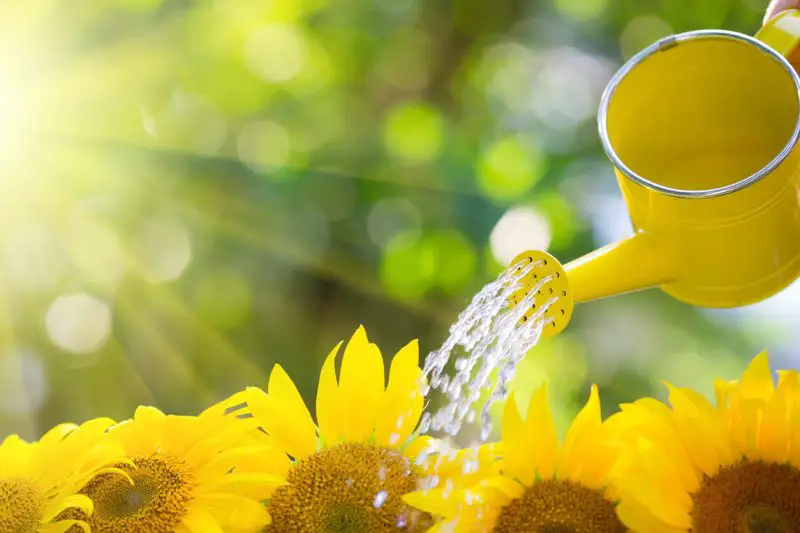Sunflowers are stunning, iconic plants that brighten any garden with their tall stems and vibrant yellow blooms. Yet, many gardeners struggle to keep them healthy and thriving. One of the most common challenges is knowing exactly how much water they need. Too little or too much can stunt growth, weaken stems, and reduce flower production.
In this guide, you’ll discover expert tips on watering sunflowers correctly, learn to recognize signs of overwatering and underwatering, and avoid mistakes that can harm your plants. By understanding their water needs and following practical advice, you can grow strong, tall sunflowers that produce abundant, long-lasting blooms all season.
Understanding Sunflower Water Needs

Sunflowers are hardy plants, but water is essential for healthy growth. Their deep roots can reach moisture from lower soil layers. Young sunflowers need frequent watering to establish strong roots. Overwatering or underwatering can negatively affect growth and flower production.
Factors such as soil type, weather, and growth stage influence water needs. Sandy soils drain quickly, requiring more frequent watering. Clay soils hold moisture longer, so overwatering can cause root rot. Container-grown sunflowers need more attention because soil dries faster. Monitoring soil moisture helps determine when watering is needed.
Check soil by inserting your finger about two inches deep. If dry, water immediately. Morning is the best time to water. This reduces evaporation and allows leaves to dry before night. Wet leaves overnight can encourage fungal diseases. Mulching around the base conserves moisture and reduces the need for frequent watering. Understanding these basics prevents common watering mistakes and promotes healthy growth throughout the season.
Signs Your Sunflowers Are Underwatered
Sunflowers that receive insufficient water show visible signs. Leaves may curl, wilt, or brown at the edges. Young plants are especially sensitive to drought stress. Growth may be stunted, and flowers appear smaller than usual.
Weak roots can cause stems to bend or break in wind. Flower heads may dry out before fully opening. In severe cases, the plant may die. Regularly check soil moisture to prevent stress. Insert your finger about two inches into the soil. If dry, water deeply to encourage downward root growth.
Shallow watering leads to weak surface roots. Mulching helps retain soil moisture and regulate temperature. Water only around the root zone, avoiding leaves. Early observation of these signs ensures sunflowers remain healthy, tall, and vibrant.
Signs of Overwatering in Sunflowers
Too much water can be as harmful as too little. Excess moisture reduces oxygen in the soil, suffocating roots. Leaves may turn yellow and droop even with adequate sunlight. Rotting roots prevent nutrient uptake and weaken stems.
Constantly wet soil encourages fungal growth. Signs include soft stems, slow growth, and small flowers. Overwatered sunflowers are more vulnerable to pests. Container-grown plants are at higher risk due to poor drainage. Watering frequency should consider soil type and drainage.
Watering in the morning allows soil to dry during the day. Avoid a strict schedule without checking soil moisture first. Stick your finger into the soil; if moist, skip watering. Mulching helps regulate moisture and prevents overwatering or drying out. Early detection of overwatering protects roots and supports healthy blooms.
Best Watering Practices for Young Sunflowers
Young sunflowers need special care in the first few weeks. Proper watering establishes strong root systems. Soil should remain evenly moist but not soggy. Shallow watering can produce weak surface roots. Deep watering encourages roots to grow downward.
Morning watering minimizes evaporation and prevents fungal infections. Monitor soil daily as young plants are sensitive to drying. During hot weather, watering may be needed twice daily. Use a small hose or drip irrigation to provide even moisture around the root zone.
Mulch helps retain water and suppress weeds. Avoid heavy fertilization until roots are well established. Too much water combined with fertilizer can damage roots. Gradually reduce watering as plants mature to train roots to reach deeper water sources. Proper early care results in tall, healthy sunflowers with large, vibrant blooms.
Best Watering Practices for Mature Sunflowers
Mature sunflowers require a different approach than seedlings. Their deep roots allow tolerance for short dry periods. However, consistent moisture during flowering ensures maximum bloom size. Deep watering once or twice a week is often sufficient.
Adjust watering based on rainfall and soil type. Mulching reduces evaporation and stress. Avoid shallow watering, which encourages surface roots. Drip irrigation or small hoses provide effective watering. Morning is ideal to prevent leaf diseases.
Check soil moisture about four inches below the surface for accuracy. After flowering, gradually reduce watering to prepare plants for seed maturation. Healthy leaves and full flowers indicate proper watering. Adequate water supports strong stems, vibrant blooms, and healthy seeds.
Common Watering Mistakes to Avoid
Overwatering Sunflowers
Overwatering is one of the most common mistakes gardeners make. Excess water reduces oxygen in the soil, suffocating roots. This slows growth and makes stems weak. Leaves often turn yellow or droop, even under adequate sunlight. Flower heads may remain small or fail to open.
Soil that stays constantly wet promotes fungal diseases and root rot. Container-grown sunflowers are particularly vulnerable due to poor drainage. Deep, infrequent watering is better than frequent shallow watering. Always check soil moisture before watering. Insert your finger two inches into the soil; if it feels moist, skip watering. Mulching helps regulate soil moisture and prevents both overwatering and evaporation. Recognizing the signs early saves your plants from long-term damage and ensures stronger, healthier blooms throughout the season.
Underwatering Sunflowers
Underwatering is another common error that can stunt growth. Sunflowers need consistent moisture, especially during their early stages and flowering period. Leaves may curl, wilt, or brown at the edges. Stems may appear weak, and flowers often remain smaller or dry out prematurely.
Shallow watering is a frequent culprit. It encourages surface roots rather than strong, deep roots. Deep watering ensures roots grow downward, increasing drought resilience. Mulching around the base helps retain soil moisture. Check soil moisture regularly, especially in hot or dry weather. Watering only when leaves look wilted is too late. Observing early signs of underwatering allows timely intervention. Proper hydration results in tall, robust plants with abundant, vibrant flowers that last through the season.
Inconsistent Watering Practices
Many gardeners water sunflowers irregularly, causing stress to the plants. Inconsistent watering can lead to uneven growth, smaller flowers, and weaker stems. Plants that alternate between dry and overly wet conditions struggle to establish strong roots.
Maintaining a consistent watering schedule is key, but always adjust based on weather and soil conditions. Morning watering helps reduce evaporation and keeps leaves dry, lowering disease risk. Mulching helps moderate moisture fluctuations. Avoid following a strict schedule without checking soil. Observing soil depth and plant condition ensures that watering is done only when necessary. Consistent moisture helps flowers bloom uniformly and supports overall plant health.
Watering the Leaves Instead of the Roots
Watering directly on leaves is a common mistake that encourages fungal and bacterial diseases. Wet leaves overnight create a perfect environment for mold and mildew, especially in humid climates. Sunflowers can develop leaf spots, stem rot, or other infections from prolonged wet foliage.
Focus watering on the soil around the root zone. Drip irrigation or soaker hoses are ideal to deliver water directly to roots. Water deeply to encourage downward root growth, which strengthens stems and supports flower development. Mulching further prevents surface evaporation and protects roots. By watering roots rather than leaves, sunflowers remain healthier, produce stronger stems, and develop larger, long-lasting blooms throughout the growing season.
Ignoring Soil Type
Ignoring soil type is a frequent error that affects sunflower health. Different soils retain and drain water differently. Sandy soils drain quickly, requiring more frequent watering. Clay soils hold water longer, so overwatering can easily cause root rot. Loamy soils provide a balanced moisture environment, but still need monitoring.
Adjusting watering practices according to soil type ensures that sunflowers receive adequate moisture without stress. For sandy soils, deep watering encourages roots to grow downward. For clay soils, water slowly to prevent pooling. Mulching is effective for all soil types, as it reduces evaporation and regulates temperature. Containers require special attention because soil dries faster than garden beds. By understanding soil characteristics, gardeners can avoid under- or overwatering, ensuring strong roots, taller stems, and abundant flowers. Observing soil moisture regularly is key to adapting watering to each specific environment.
Watering at the Wrong Time of Day
Watering sunflowers at the wrong time can reduce efficiency and increase disease risk. Watering in the evening leaves leaves wet overnight, creating a perfect environment for fungal infections. Morning watering is ideal because sunlight helps evaporate moisture from leaves while keeping roots hydrated.
Avoid watering during the hottest part of the day. Midday watering wastes water due to rapid evaporation and can shock the plant’s roots. Using drip irrigation or a slow hose ensures water reaches the soil and roots efficiently. Mulching further conserves moisture and prevents surface drying. By timing watering correctly, gardeners can maximize water absorption, prevent disease, and promote healthier stems and larger, vibrant blooms. Proper timing helps sunflowers thrive even in challenging climates.
Seasonal Watering Adjustments
Spring Watering Practices
Spring is a critical time for sunflowers as they establish roots and begin growth. Young plants need consistent moisture to develop strong roots. Soil should be kept evenly moist but not waterlogged. Shallow watering should be avoided because it encourages weak surface roots.
Morning watering is ideal to reduce evaporation and prevent fungal problems. Check soil daily, especially during dry spells or after transplanting seedlings. Mulching around the base helps retain moisture and regulate temperature. Avoid overfertilizing at this stage, as excessive nutrients combined with water stress can damage young roots. By providing proper spring watering, sunflowers grow tall, develop strong stems, and prepare for robust flowering in the upcoming season.
Summer Watering Practices
Summer brings higher temperatures and increased evaporation, requiring careful attention to watering. Deep, infrequent watering is best, usually once or twice per week, depending on soil type and rainfall. Shallow watering can lead to weak roots and stressed plants.
Mulching is crucial in summer to preserve soil moisture and reduce heat stress. Monitor leaves for early signs of drought, such as curling or drooping. Container-grown sunflowers need more frequent checks because pots dry out faster. Morning watering allows soil to absorb moisture before the heat of the day, reducing evaporation. Proper summer watering ensures tall, strong plants with abundant, vibrant blooms that withstand high temperatures.
Fall and Winter Watering Practices
In fall, mature sunflowers begin focusing on seed development. Watering should be reduced gradually to encourage strong root systems and harden stems. Excess water during cooler months can cause root rot and fungal growth.
Monitor soil moisture carefully, especially if rainfall is low. Deep watering is still beneficial, but less frequent than in summer. In winter, sunflowers in mild climates need minimal watering. Containers should be watered sparingly to avoid soggy soil. Mulching helps insulate roots from fluctuating temperatures. By adjusting watering with seasonal changes, sunflowers remain healthy, produce strong stems, and support seeds and flowers that last longer.
Watering Sunflowers in Different Soil Types
Container Size and Soil Choice
The size of the container greatly affects sunflower watering. Larger pots retain moisture longer, while smaller containers dry quickly. Choose pots with sufficient depth to allow deep root growth. Proper soil is equally important. Use well-draining potting mix to prevent waterlogging. Avoid heavy garden soil, which retains too much water and can suffocate roots.
Add organic matter, such as compost, to improve water retention and nutrients. Mulching on the soil surface reduces evaporation and protects roots from temperature fluctuations. Regularly check moisture levels by inserting a finger 2–3 inches into the soil. Containers need closer monitoring than in-ground sunflowers because water evaporates faster and temperature changes are more extreme. By selecting the right container size and soil, you provide a solid foundation for healthy, strong, and vibrant sunflowers.
Watering Frequency for Container-Grown Sunflowers
Container-grown sunflowers require careful watering due to limited soil volume. Small pots may need daily watering during hot weather. Larger containers require less frequent irrigation but still need deep watering to encourage root growth. Shallow watering creates weak surface roots prone to stress.
Water directly at the base, avoiding leaves to prevent fungal issues. Morning watering is ideal to reduce evaporation and allow soil to dry during the day. Mulching helps retain moisture and stabilizes soil temperature. Adjust frequency according to plant size, growth stage, and weather conditions. Regular checks of soil moisture are critical. Proper watering in containers ensures strong stems, vibrant flowers, and healthy root systems that support long-lasting blooms.
The Role of Mulching in Water Retention
Mulching supports sunflower hydration and reduces water stress. Organic mulch such as straw or bark conserves soil moisture. It lowers evaporation, stabilizes soil temperature, and suppresses weeds. Mulch also encourages beneficial soil organisms.
Apply mulch around the root zone but keep it away from the stem to prevent rot. A 2–3 inch layer is effective. Mulching reduces the frequency of watering, especially in hot weather. In containers, mulch prevents soil from drying too quickly. Monitor and replenish mulch as it decomposes.
Mulching promotes healthy roots, larger flowers, and stronger stems. Combined with proper watering, mulch prevents common mistakes like overwatering or underwatering. Sunflowers grow taller, stronger, and bloom more vibrantly with consistent mulch use. Proper mulch management is a key part of a successful watering strategy.
Watering Sunflowers in Containers
Container-grown sunflowers require extra attention because soil dries faster than in the ground. Pots and planters have limited soil volume, which can heat up quickly in sunlight. This increases evaporation and stress for the plant. Regular monitoring of soil moisture is essential.
Watering should be deep but controlled. Allow water to soak evenly through the soil, ensuring roots at all levels receive moisture. Avoid letting water pool at the bottom of the container. Proper drainage holes are necessary to prevent root rot.
Mulching on the soil surface of containers can reduce evaporation. In very hot conditions, consider moving containers to slightly shaded areas during peak sun. Observe plant leaves daily; drooping or curling indicates the need for immediate watering. Consistent care ensures healthy growth, tall stems, and large, vibrant flowers in container-grown sunflowers.
Drought Resistance Tips for Sunflowers
Drought-Resistant Varieties
Selecting drought-resistant sunflower varieties reduces water stress and improves survival during dry periods. These cultivars have deeper roots, stronger stems, and better heat tolerance. Choosing the right variety makes maintaining consistent blooms easier, even in challenging climates.
Drought-resistant plants still benefit from deep, infrequent watering. Encourage root growth by allowing soil to dry slightly between watering sessions. Mulching further conserves water and regulates temperature. Observe for early signs of stress, such as drooping leaves or slow growth, and water accordingly. Combining drought-tolerant varieties with proper care results in taller, stronger sunflowers with abundant flowers, even in dry or hot conditions.
Strategies to Improve Drought Tolerance
Sunflowers naturally tolerate short dry periods, but stress can be reduced with careful techniques. Deep watering encourages roots to grow downward, increasing resilience. Avoid frequent shallow watering, which produces weak, surface roots prone to wilting.
Mulching conserves soil moisture and reduces heat stress. Select planting sites with some afternoon shade if possible, especially in hot climates. Grouping plants with similar water needs also improves efficiency. Monitoring soil regularly and adjusting watering based on plant signs ensures sunflowers survive dry spells. These strategies support tall, healthy plants with large, vibrant blooms, even under limited water conditions.
Efficient Irrigation Systems for Sunflowers
Drip Irrigation for Sunflowers
Drip irrigation is highly effective for sunflowers, especially in larger gardens. Water is delivered directly to the root zone, minimizing evaporation and water waste. This method also keeps leaves dry, reducing the risk of fungal diseases.
Drip lines can be laid along rows or around individual plants. Timers automate watering, ensuring consistency and reducing human error. Adjust flow rates based on soil type, plant size, and weather conditions. Deep, slow watering encourages roots to grow downward, strengthening stems and improving drought resistance.
Mulching works well with drip irrigation, retaining soil moisture and further protecting roots from heat. Compared to sprinklers, drip systems are more efficient, especially in hot climates. Consistent moisture promotes taller plants, larger flowers, and healthier root systems. Investing in a drip system simplifies care while maximizing sunflower growth and bloom quality.
Soaker Hoses for Efficient Watering
Soaker hoses are another practical irrigation method. They deliver water slowly and evenly along the length of the hose, directly to the soil. This prevents surface runoff and ensures roots receive adequate moisture.
Lay hoses around the base of plants and cover with mulch for better efficiency. Avoid watering leaves to reduce disease risk. Soaker hoses work well for both in-ground and container sunflowers. Schedule watering in the morning to allow soil to absorb water before the heat of the day.
This method reduces labor and improves plant health. Consistent moisture supports strong stems and larger flowers. Soaker hoses are simple, cost-effective, and suitable for gardeners seeking an efficient watering solution for sunflowers of all sizes.
FAQ: Common Sunflower Watering Questions
How often should I water sunflowers at different growth stages?
Seedlings need frequent, gentle watering to establish strong roots. As they mature, sunflowers require deep watering once or twice a week. Soil type, temperature, and rainfall affect frequency. Monitoring soil moisture is essential to avoid over- or underwatering throughout growth stages.
How can I tell if my sunflower is underwatered or overwatered?
Underwatered sunflowers show curling, drooping, or yellowing leaves and stunted growth. Overwatered plants develop yellow leaves, soft roots, drooping stems, and may have soil that stays soggy for days. Observing both soil moisture and plant behavior ensures timely intervention and healthy growth.
Should I water sunflower leaves or roots?
Always focus water on the root zone. Wet leaves promote fungal infections and bacterial diseases, especially in humid conditions. Drip irrigation or slow watering at the base ensures roots absorb moisture efficiently, encouraging strong stems and vibrant blooms.
How does soil type influence watering needs?
Sandy soils drain quickly and require more frequent watering, while clay soils retain moisture, increasing the risk of root rot. Loamy soil balances drainage and retention. Adjust watering depth and frequency according to soil texture, and use mulch to conserve moisture and regulate temperature.
How should I adjust watering during flowering, drought, or heat waves?
During flowering, maintain consistent moisture to support large blooms and strong stems. In drought or heat, water deeply and less frequently to encourage deep root growth. Mulching and partial shade reduce stress and prevent soil from drying too quickly, keeping plants healthy and resilient.
Conclusion
Proper watering is key to growing tall, vibrant sunflowers. Understanding their water needs, monitoring soil, and avoiding common mistakes ensures strong stems and abundant blooms. Mulching, seasonal adjustments, and efficient irrigation protect roots and maintain consistent moisture. Container-grown plants or gardens in dry climates benefit from deep, careful watering. By following these expert tips, your sunflowers will thrive, producing large, long-lasting flowers that brighten your garden all season. Healthy watering practices transform ordinary plants into stunning, resilient, and cheerful garden highlights.






